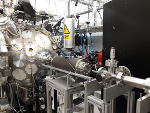| 9 | | The ‘Laser-hybrid Accelerator for Radiobiological Applications’, LhARA, is conceived as a novel uniquely-flexible facility dedicated to the study of radiobiology. The technologies demonstrated in LhARA, which have wide application, may be developed to allow particle-beam therapy to be delivered in a completely new regime, combining a variety of ion species in a single treatment |
| 10 | | fraction and exploiting ultra-high dose rates. LhARA will be a hybrid accelerator system in which laser interactions drive the creation of a large flux of protons or light ions that are captured using |
| 11 | | a plasma (Gabor) lens and formed into a beam. The laser-driven source allows protons and ions to be captured at energies significantly above those that pertain in conventional facilities, thus |
| 12 | | evading the current space-charge limit on the instantaneous dose rate that can be delivered. The laser-hybrid approach, therefore, will allow radiobiological studies to be carried out in completely |
| 13 | | new regimes, delivering protons and light ions in a wide variety of time structures, spectral distributions, and spatial configurations at instantaneous dose rates up to and significantly beyond |
| 14 | | the ultra-high dose-rate ‘FLASH’ regime. |
| | 9 | The ‘Laser-hybrid Accelerator for Radiobiological Applications’, LhARA, is conceived as a novel uniquely-flexible facility dedicated to the study of radiobiology. The technologies demonstrated in LhARA, which have wide application, may be developed to allow particle-beam therapy to be delivered in a completely new regime, combining a variety of ion species in a single treatment fraction and exploiting ultra-high dose rates. LhARA will be a hybrid accelerator system in which laser interactions drive the creation of a large flux of protons or light ions that are captured using a plasma (Gabor) lens and formed into a beam. The laser-driven source allows protons and ions to be captured at energies significantly above those that pertain in conventional facilities, thus evading the current space-charge limit on the instantaneous dose rate that can be delivered. The laser-hybrid approach, therefore, will allow radiobiological studies to be carried out in completely new regimes, delivering protons and light ions in a wide variety of time structures, spectral distributions, and spatial configurations at instantaneous dose rates up to and significantly beyond the ultra-high dose-rate ‘FLASH’ regime. |
